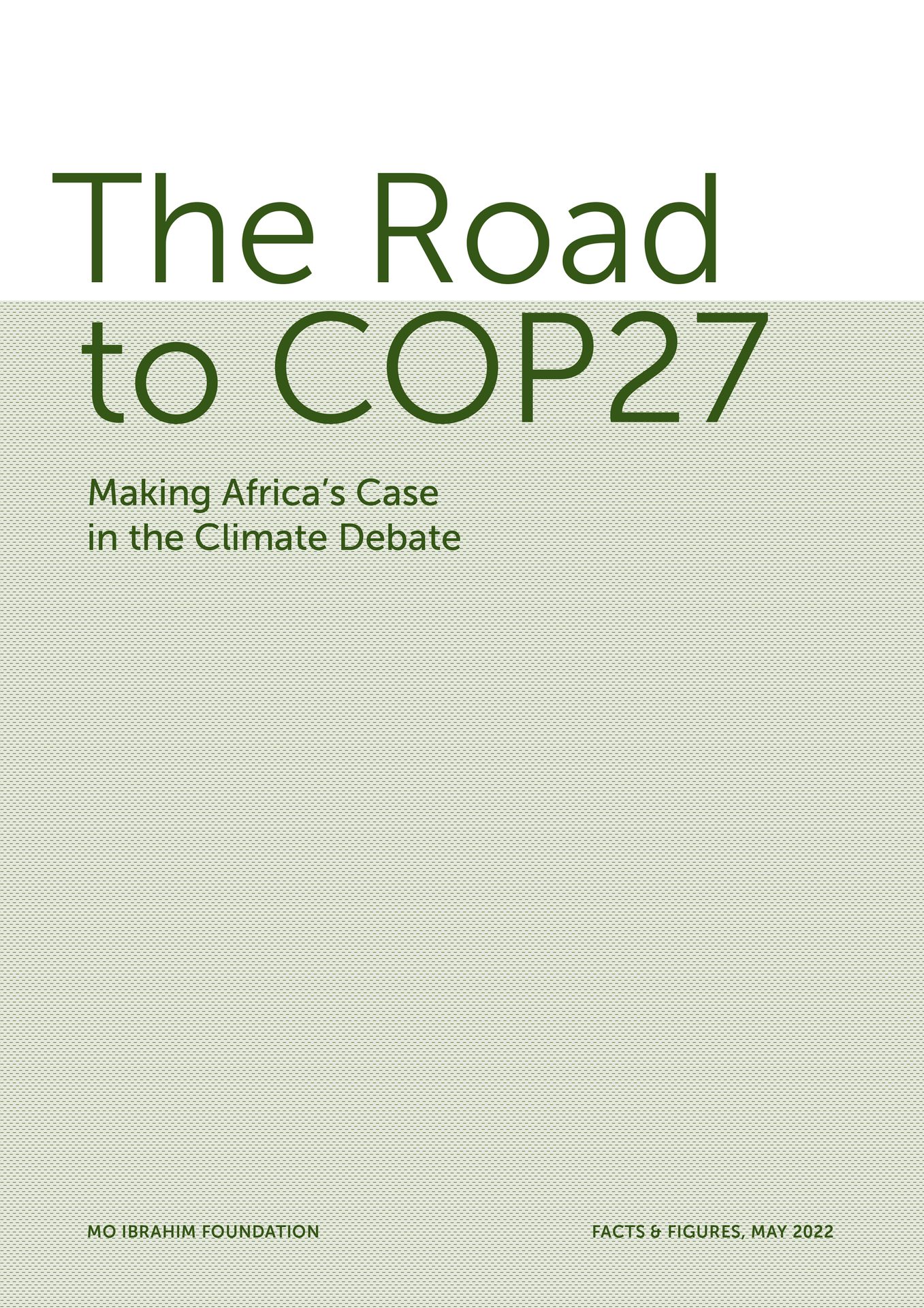Download document

Following the Ibrahim Governance Forum, the Mo Ibrahim Foundation published the Ibrahim Forum Report, The Road to COP27: Making Africa’s Case in the Climate Debate, combining the latest data on the climate crisis in Africa with the key takeaways from the Ibrahim Governance Forum, putting forward 15 recommendations for how policymakers and climate leaders can articulate Africa’s case in the global climate debate and ensure the continent’s interests are no longer marginalised.
Africa faces the greatest challenges of any region in terms of energy access, with the continent accounting for 17% of the world’s population but only 5.9% of the world’s energy supply.
The discrepancy with other regions is stark. North America’s per capita energy supply is more than eight times that of Africa’s, while the per capita supplies of Europe and the Middle East are each more than four times as high.
Energy apartheid threatens development goals in Africa

There is no development without power.
Mo Ibrahim








4x









8x
Due to this lack of energy, only 55.7% of the continent’s population has access to electricity, as opposed to over 90% for the rest of the world.
More than 600 million people in Africa are without access to electricity, while over 930 million lack access to clean cooking fuel.
Africa’s growing demographic adds another dimension to the continent’s challenging energy landscape.
By 2050, Africa’s population is projected to be double that of 2020, while by 2100 it will have increased more than three-fold.
This rapid growth in population only makes the need to expand the energy supply more pressing. Without action, millions more Africans will be consigned to energy poverty.
Africa’s population: projected change
Growing demand and a widening energy gap
Between 2010 and 2019, African governments have more than tripled public investment in renewables, and 22 African countries already utilise renewables as their main electricity source.
However, much of the continent’s renewable potential remains untapped.
Africa accounts for 40% of the world’s total solar potential, yet only hosts 1% of the world’s panels.
Damilola Ogunbiyi
Renewables: one part of the solution

We have to supply adequate clean cooking, we have to supply gas to integrate as a baseload for renewable. Renewables don’t just happen magically.
Africa
Of the 21 African countries with known geothermal resources, only Ethiopia and Kenya currently utilise geothermal for electricity generation, while Africa has only tapped into 0.01% of its potential wind power.
Renewables alone remain far from being able to close Africa’s energy gap. Wind and solar are intermittent, while energy storage technology is some way off being available at scale. Renewable hydropower, meanwhile, is vulnerable to climate change.



accounts for 40% of the world’s total solar potential
hosts 1% of the world’s panels
Natural gas: a key transitional fuel
To facilitate the widespread energy access needed to industrialise and achieve the continent’s development goals in the short to medium term, Africa will need to use its natural gas reserves (455.2 trillion cubic feet in 2020) as a base fuel to complement renewables. But this will require investment.
The International Energy Agency (IEA) projects that to achieve universal access to modern energy services in Africa, as well as the continents climate pledges, natural gas will have to account for nearly half of fuel supply investment and over 10% of newly installed power capacity until 2030.
Africa currently uses the least fossil fuels in its energy supply, globally. If the whole of sub-Saharan Africa (minus South Africa) were to triple its electricity consumption using entirely gas it would only increase global carbon emissions by 0.6%.
of the world’s mineral reserves are in Africa
30%
Natural gas is also the cleanest burning fossil fuel and can replace more polluting fossil fuels such as coal, which produces almost twice as much CO2 per million units of energy as gas, and oil, which produces roughly one third more.
The one-size-fits-all approach to fossil fuel financing at COP26 ignored Africa’s energy poverty, small carbon footprint and the continent’s right to development.
COP27 is an opportunity to reverse these policies and ensure that climate commitments do not come at the expense of Africa’s development.
Chris Gentle
It would be naïve to think that development can take place in Africa with no hydrocarbons at all.


Key recommendations for COP27
Balance net-zero, energy access, and energy security
Whether for gas or renewables, look beyond just production alone
Clean cooking solutions are key to both climate and health goals
Consider gas as a key transitional fuel, to be developed in parallel with renewables
Over 600 million people still lack access to electricity in Africa. This constitutes a global injustice, while in the rest of the world 90% of the population have access to electricity.
Build maintenance, storage, transport capacities: this means public planning, financial resources and additional skills.
In sub-Saharan Africa, around 70% of households depend on wood fuel for energy, which produces almost twice as much carbon per million units of energy as gas and contributes to deforestation.
Renewables are already the main source of electricity for almost half of Africa. However, renewables alone are unable to address the current energy gap on the continent.




Mo Ibrahim
Mamadou Fall Kane
Sidi Ould Tah
There is no development without power.
We need to first create an integrated infrastructure to distribute to neighbours. The AfCFTA is a first step in this direction.
We have to take into consideration the cultural aspect. Sometimes it is not about affordability and access. It is about culture.



Amina Mohammed
An essential element of COP27 must be a just, fair and equitable energy transition for Africa, one that recognises the unique and special situation and circumstances of Africa, and includes addressing and funding a transitional energy mix, reducing emissions, and providing energy access to the 600 million Africans who still lack it.

David Malpass
Building a more resilient Africa cannot mean slowing down development or the progress towards achieving SDG7 on energy.




